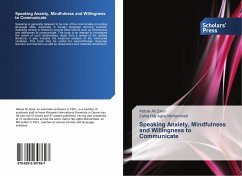
Willingness to Communicate of Foreign Language Learners
A WTC Study in a Chinese Setting
Versandkostenfrei!
Versandfertig in 6-10 Tagen
39,99 €
inkl. MwSt.

PAYBACK Punkte
20 °P sammeln!
As an English language learner and teacher,I havewitnessed a common phenomenon of a mismatch betweenlearners'' willingness to communicate in English andtheir actual English proficiency. It was not unusualthat individuals who could obtain high scores instandardized English proficiency tests, such asTOEFL, GRE, and GMAT, could barely carry outpragmatic conversation in English. The lack ofpractice opportunities in the environment, in whichEnglish was primarily studied as a school subject andused exclusively inside the classroom, seemed to bethe principal reason for students'' low capability inEng...
As an English language learner and teacher,I have
witnessed a common phenomenon of a mismatch between
learners'' willingness to communicate in English and
their actual English proficiency. It was not unusual
that individuals who could obtain high scores in
standardized English proficiency tests, such as
TOEFL, GRE, and GMAT, could barely carry out
pragmatic conversation in English. The lack of
practice opportunities in the environment, in which
English was primarily studied as a school subject and
used exclusively inside the classroom, seemed to be
the principal reason for students'' low capability in
English communication. However, not until I became a
teacher of an Oral English class a couple of years
ago did I realize that most of the students in the
class were reluctant to participate in English
communication even when they were given sufficient
communication opportunities.
This book is expected to answer the following
questions: What are the causes of students''
unwillingness to communicate in English? What factors
could be influential toward students'' English
communication willingness? How could the factors, if
any, affect students'' willingness to communicate in
English?
witnessed a common phenomenon of a mismatch between
learners'' willingness to communicate in English and
their actual English proficiency. It was not unusual
that individuals who could obtain high scores in
standardized English proficiency tests, such as
TOEFL, GRE, and GMAT, could barely carry out
pragmatic conversation in English. The lack of
practice opportunities in the environment, in which
English was primarily studied as a school subject and
used exclusively inside the classroom, seemed to be
the principal reason for students'' low capability in
English communication. However, not until I became a
teacher of an Oral English class a couple of years
ago did I realize that most of the students in the
class were reluctant to participate in English
communication even when they were given sufficient
communication opportunities.
This book is expected to answer the following
questions: What are the causes of students''
unwillingness to communicate in English? What factors
could be influential toward students'' English
communication willingness? How could the factors, if
any, affect students'' willingness to communicate in
English?












